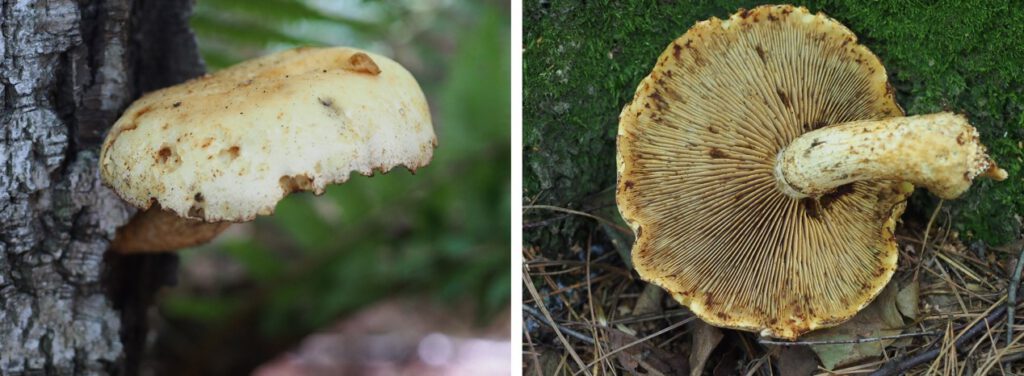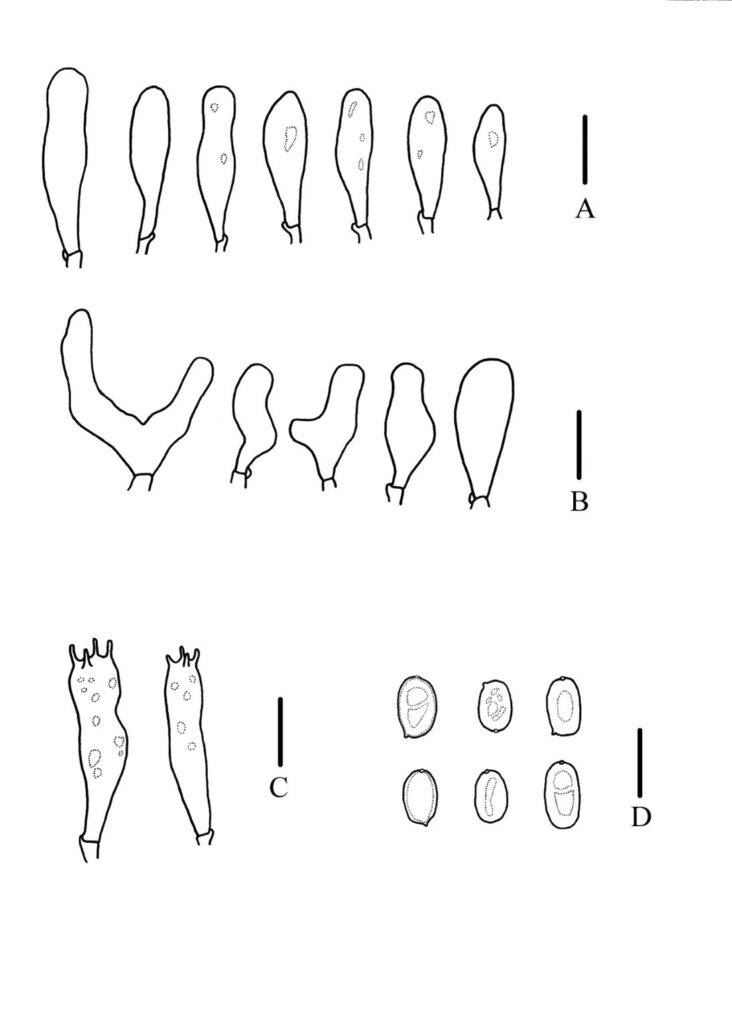Pholiota betulicola Tolgor Bau & Enjing Tian sp. nov. (Figures 1, 2)
MycoBank number: MB 559944; Index Fungorum number: IF 559944; Facesoffungi number: FoF 12906;
Description
Pileus 11 cm in diameter, convex; surface slightly viscid, with appressed light brown (6D6) minute fibrillose spots; brownish yellow (5C8) at center, becoming yellowish white (1A2) to white towards the margin; the margin irregularly undulate. Context thick, firm, yellowish white (2A2), odor distinct spicy-aromatic. Lamellae adnexed, broad, close, L=60–65, I=3–7, dark blonde (5D4), the edges even. Stipe 5 cm long, 1.9 cm thick, central or eccentric, slightly enlarged at the base, hard, solid, smooth and white above the annulus, ground color whitish and with brownish longitudinal stripes and brown fibrillose squamules below the annulus, with yellowish white (1A2) tomenta near the base. Partial veil leaving an annular zone. Spore print cinnamon brown (6D6). Basidiospores (6.5) 7.5–10 × (3.7) 4.5–5 μm, Q = (1.25) 1.5–2, in face view elliptic, oblong to sub-rectangle, rarely broadly elliptic, in side view elliptic, somewhat inequilateral to slightly reniform, wall smooth and thick, germ pore minute, pale rusty, yellow-brownish to pale brown in KOH, slightly paler in Melzer’s reagent. Basidia 22–28 × 5–7.5 μm, 4-spored, clavate, hyaline in KOH. Pleurocystidia 15–27 × 4.5–5 μm, buried in the hymenium, clavate to subfusiform, sometimes with refractive and amorphous-granular content, wall thin, smooth, pale tawny to dark yellow brown in KOH. Cheilocystidia 17–25 × 5–8 μm, clavate, clavate-irregular to utriform or lageniform to versiform, rarely branched, thin-walled, smooth, content homogeneous, hyaline to pale yellow brown in KOH. Caulocystidia not observed. Gill trama of parallel hyphae hyaline to yellowish in KOH,walls smooth, thin to thick, 3.5–10 μm in diam. Pileus cutis of yellowish brown to cinnamon hyphae 2.5–5 μm in diam., thin-walled, smooth. Content hyphae hyaline to yellowish in KOH, cells inflated, smooth, walls thin, interwoven. Clamp connections present in all tissues.
Material examined: CHINA. Jilin: Jiaohe city, Hongye Valley, elev. 520 m, solitary at the base of living birch in mixed broadleaf-conifer forest, 27 August 2016, Tolgor Bau HMJAU37328 (holotype); Jiaohe city, Shansongling, 1 September 2020, Yuhou Zhai, HMJAU37369.
Distribution: China, Jilin, Jiaohe city, solitary at the base of living birch in mixed broadleaf-conifer forest.
Sequence data: HMJAU37328: ITS-OP244886.1; LSU–MN251156.1; rpb2–MN329729.1; tef1-α–MN311972.1 HMJAU37369: ITS-OP244887.1, LSU-OP223414.1
Notes: This species is readily recognized due to its yellowish pileus with light brown minute fibrillose spots, thick content with distinct spicy-aromatic odor reminding of Tricholoma matsutake (S. Ito & S. Imai) Singer, whitish stipe with brownish longitudinal stripes and yellowish tomenta at the base, as well as numerous plerocystidia buried in hymenium and sometimes sub-rectangle basidiospores.
Growing on living trees and the large and robust basidiocarp of this species remind one of Pholiota populnea (Pers.) Bon. However, the pileus of the latter has no yellow tone and covers with conspicuous floccose or patches scales, and the lack of the pleurocystidia and cylindric-capitate cheilocystidia also make it differ from P. betulicola.

Fig. 1 Basidiome of Pholiota betulicola (HMJAU37328). Photo by T. Bau.

Fig. 2 Pholiota betulicola A. Pleurocystidia; B. Cheilocystidia; C. Basidia; D. Basidiospores. Bars=10μm. Drawings by E. Tian.
